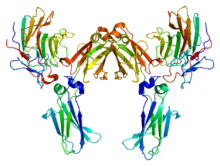Intracellular antibody-mediated degradation

Two TRIM21 (top left and right) bound to the constant region of IgG1 (middle), after 2iwg
The intracellular antibody-mediated degradation (engl. Intracellular antibody-mediated degradation , IAMD) denotes the intracellular degradation of antigens by binding of an antibody .
properties
The intracellular antibody-mediated degradation takes place through binding of the antibody to TRIM21 (an F c receptor ), which, after ubiquitination of TRIM21, causes the antigen-antibody complex to be degraded in the proteasome . This neutralizes the antigen. So far it has only been described for adenoviruses . In contrast to antibody-dependent cell-mediated cytotoxicity , the cell is not destroyed during intracellular antibody-mediated degradation. TRIM21 both antibodies of the type binds immunoglobulin G and immunoglobulin M and immunoglobulin A .
Individual evidence
- ^ WA McEwan, DL Mallery, DA Rhodes, J. Trowsdale, LC James: Intracellular antibody-mediated immunity and the role of TRIM21. In: BioEssays: news and reviews in molecular, cellular and developmental biology. Volume 33, number 11, November 2011, pp. 803-809, doi : 10.1002 / bies.201100093 , PMID 22006823 .
- ^ DL Mallery, WA McEwan, SR Bidgood, GJ Towers, CM Johnson, LC James: Antibodies mediate intracellular immunity through tripartite motif-containing 21 (TRIM21). In: Proceedings of the National Academy of Sciences . Volume 107, number 46, November 2010, pp. 19985-19990, doi : 10.1073 / pnas.1014074107 , PMID 21045130 , PMC 2993423 (free full text).
- ^ S. Foss, R. Watkinson, I. Sandlie, LC James, JT Andersen: TRIM21: a cytosolic Fc receptor with broad antibody isotype specificity. In: Immunological reviews. Volume 268, number 1, November 2015, pp. 328–339, doi : 10.1111 / imr.12363 , PMID 26497531 , PMC 4670481 (free full text).